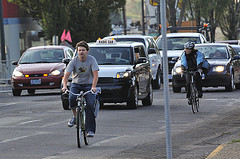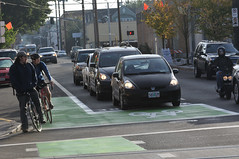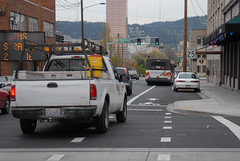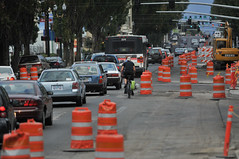Mayor Sam Adams emceed an event this morning to mark the official grand opening of the East Burnside/Couch Couplet project. The project (which is still not quite finished) began nearly eight years ago and the estimated cost is about $17.8 million. Adams touted the project as a beacon for everything Portland stands for, saying it’s now a multi-modal, “green” corridor that will reduce traffic crashes and boost local businesses, all while being easier to navigate on foot and by bike.
“This answers the question of what we can do today in the current environment with our current political will, but this doesn’t mean as a bike advocate we can’t ask for better.”
— Rob Sadowsky, BTA executive director in an interview before this morning’s event
But, while the project does have some new bike facilities and the signals make it easier to cross Burnside, one hardly gets the feeling that the safe and efficient flow of non-motorized traffic was a top priority.
The Bicycle Transportation Alliance has been vocal about their concerns with this project. A former staffer, Michael O’Leary, called NE Couch a “safety risk” and posted a statement on the BTA blog outlining several reasons he felt the couplet was “not ready to ride.”
The s-curve bike lane on Couch leading onto the bridge raised red flags as soon as it was installed. Heeding safety concerns, PBOT acknowledged a striping error and remedied the situation.
Concerns — exacerbated by a right-hook collision last month — then turned toward the new bike lane on NE Couch, which can lead to right-hooks by forcing bike traffic to the right of right-turning motor vehicle traffic. PBOT addressed these concerns by installing a bike box at the intersection a few weeks ago.
Today, BTA executive director Rob Sadowsky had the opportunity to address these issues in front of a crowd of notables which included Congressman Earl Blumenauer, Mayor Sam Adams, and PBOT Director Sue Keil.
Here’s an excerpt from Sadowsky’s comments:
“The improvements integrated into this design will help reduce traffic conflicts between motorists and bicyclists and pedestrians, and ease trips into the city across the Burnside Bridge by providing clearer direction and safer route choices for bicyclists.
One of the things that we, as bicyclists, are most pleased about is the timing of the lights on Couch as you’re coming into the bridge. Travel speeds are now at or below 20 mph, providing safer speeds for shared traffic. When you add bike boxes and bike lanes into that mix, creating safer places for people aged 8-80, we are well on our way to making bicycling accessible and safe for all riders.
We also share that there is more to be done to ensure the safety of all road users in this city and this couplet to ease the overall commute to and from the city through this corridor…”
Sadowsky also said we need to build more physically separated bikeways on high-traffic, high-visibility commercial streets and that it would take a new federal transportation bill to take the “next big steps.” In closing, he said,
“So let’s celebrate another step in building out the visionary Portland Bicycle 2030 Plan while we set our sights even higher for even bigger and bolder investment in this great livable city.”
Sadowsky’s conciliatory tone this morning is not surprising. He has to walk a fine line between partnership and support of Mayor Adams while giving voice to his member’s concerns. I asked Sadowsky about the project and the tone he planned to strike at the event before he gave his speech.
About the project, Sadowsky said,
“I think it provides a lot of contradictions. In some ways it starts to approach accomodation and a clear sense of ‘bicycles are welcome here’… but on the other hand there’s unfinished business… This answers the question of what we can do today in the current environment with our current political will, but this doesn’t mean as a bike advocate we can’t ask for better… This is a good first step.”
This “first step” included several new bike facilities. Northbound on NE 12th is now much easier to navigate, there are new bike lanes on NE Couch from 6th all the way onto the Burnside Bridge and a bike lane on Burnside is set to be installed from the bridge to NE 13th any day now. Another key feature for bike traffic is the timing of signals on NE Couch, which are set for a comfortable biking speed of about 15 mph.
For motor vehicle traffic, the project boasts “enhanced traffic flow” (according to a PBOT press release) due to the one-way couplet on Burnside and Couch between NE Third and NE 14th, improved access to businesses with left turns at all intersections, and new on-street parking spaces on Burnside.
Maintaining motor vehicle parking was a major factor in the design of this project. As I reported last year, PBOT project manager Bill Hoffman said businesses opposed the removal of any parking at all. That stance led to Mayor Adams’ decision to narrow the sidewalk by five feet on Couch (from 12 to seven feet) to make room for the bike lane while maintaining space for parked cars.
The centerpiece of the project is lower Burnside, which has been (and is being) remade into a more pleasant shopping environment with wider sidewalks, landscaped curb extensions, and lots of new street trees. There are now fewer lanes on Burnside (from three five travel lanes to three, plus a bike lane) and signals at each cross street means traffic speeds should decrease.
Even so, Sadowsky and others are now dreaming about a bi-directional, separated cycle track on Burnside that would lead up and over the bridge into downtown (a similar idea came up three years ago and was passed over in favor of the bike lanes on NE Couch). It won’t be easy to get PBOT to re-open this discussion, but it’s certainly worth a try.
For now, I’d love to know what you think about this project. I’m happy to see the improvements, but also a bit frustrated that yet another major project has come and gone where bike traffic seems to have taken a back seat to motor vehicle “traffic flow” and parking. We have known for years that we must build physically separated bikeways in order to achieve our ridership goals. I wonder when we’ll actually start to do it.
I welcome your thoughts.
— Read past coverage of this project in our archives.





